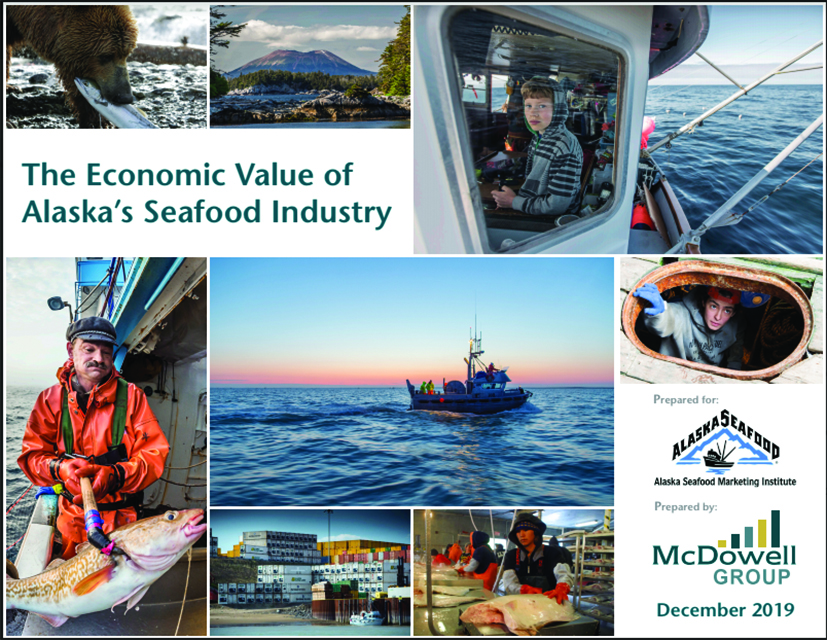For more than 30 years, Alaska has been the nation’s largest producer of seafood by volume and value. This status continues into a fourth decade, detailed in a recently published report commissioned by the Alaska Seafood Marketing Institute. Focused on the 2017-18 period, the report describes the broad economic impact of the state’s seafood industry on a regional, statewide and national level, in addition to details about global competition, tax revenue generated by the industry, and other special topics.
Over the study period, an estimated 58,700 workers were directly employed annually in the industry with wages totaling $1.7 billion. Approximately 29,400 commercial fishermen participated in Alaska’s fisheries aboard more than 9,000 vessels ranging from small skiffs to large catcher-processors. Trawl, pot, longline, gillnet and seine gear types are the primary harvest methods in Alaska’s fisheries. About 26,000 processing workers were employed across Alaska in 166 shoreside facilities, with other processors active on vessels that harvest and process their catch. About 3,300 individuals worked at salmon hatcheries, managed fisheries, marketed seafood and provided other support services.
In addition to direct employment, additional impacts occur when industry participants purchase goods or services. For example, the welder repairing a gillnet vessel or the truck driver delivering fuel to a processing plant are indirectly supported by the industry. The seafood sector is also credited with impacts associated with local government services supported by seafood-related taxes or purchases in retail stores by processing workers, for example. Including all economic impacts, 37,700 full-time equivalent jobs, $2.1 billion in wages, and $5.6 billion in economic output (a measurement that captures all economic activity) is supported by the industry in Alaska.
When considered on a national scale, the economic impact of Alaska’s seafood industry grows to an estimated 101,800 jobs with $5.6 billion in labor income and $13.9 billion in total economic output. Residents from every state in the union participate in the industry, whether working on a fishing vessel, processing seafood, conducting fisheries research, or providing marine support services.
Over the 2017-18 study period, an annual average of 5.7 billion pounds of seafood from about 100 different species were harvested in Alaska. Alaska pollock, Pacific cod, and other groundfish species accounted for 4.7 billion pounds, or 82 percent of the total harvest by volume. Salmon harvest volume totaled around 820 million pounds (14 percent of the total). And all other species including crab, halibut, and sablefish totaled nearly 100 million pounds. Fishermen earned $2 billion annually from this harvest, with groundfish contributing slightly more than $850 million, or 42 percent of the total. Led by sockeye, harvest of the five salmon species was valued at about $740 million (37 percent of total). All other species totaled roughly $400 million or about 20 percent of the total.
Alaska processors added $2.7 billion in value to the harvest through production of more than 300 unique seafood products. Over the two-year study period, the average value of all processed products totaled $4.7 billion annually. Like the harvest value, groundfish accounted for the largest share (52 percent) of the production value, salmon totaled 37 percent, and all other species accounted for the remaining 11 percent.
In addition to a strong domestic market, Alaska seafood is consumed globally. In 2018, more than 2.2 billion pounds of Alaska seafood products worth $3.2 billion were exported to nearly 100 countries. Japan and China are among the largest markets, in addition to other Asian and European Union countries.
A historical review of the Alaska seafood industry reveals a story of challenges navigated, opportunities realized, and persistent transformation. The future is expected to be similar. While challenges such as changing ocean conditions and trade disputes are formidable, modern harvesting and processing techniques, product innovation, and new markets offer significant opportunities to maintain the important economic impact of the state’s industry.
McDowell Group’s new report, The Economic Value of Alaska’s Seafood Industry, explains the industry’s economic contribution in Alaska and across the country. Download the report at www.alaskaseafood.org.







